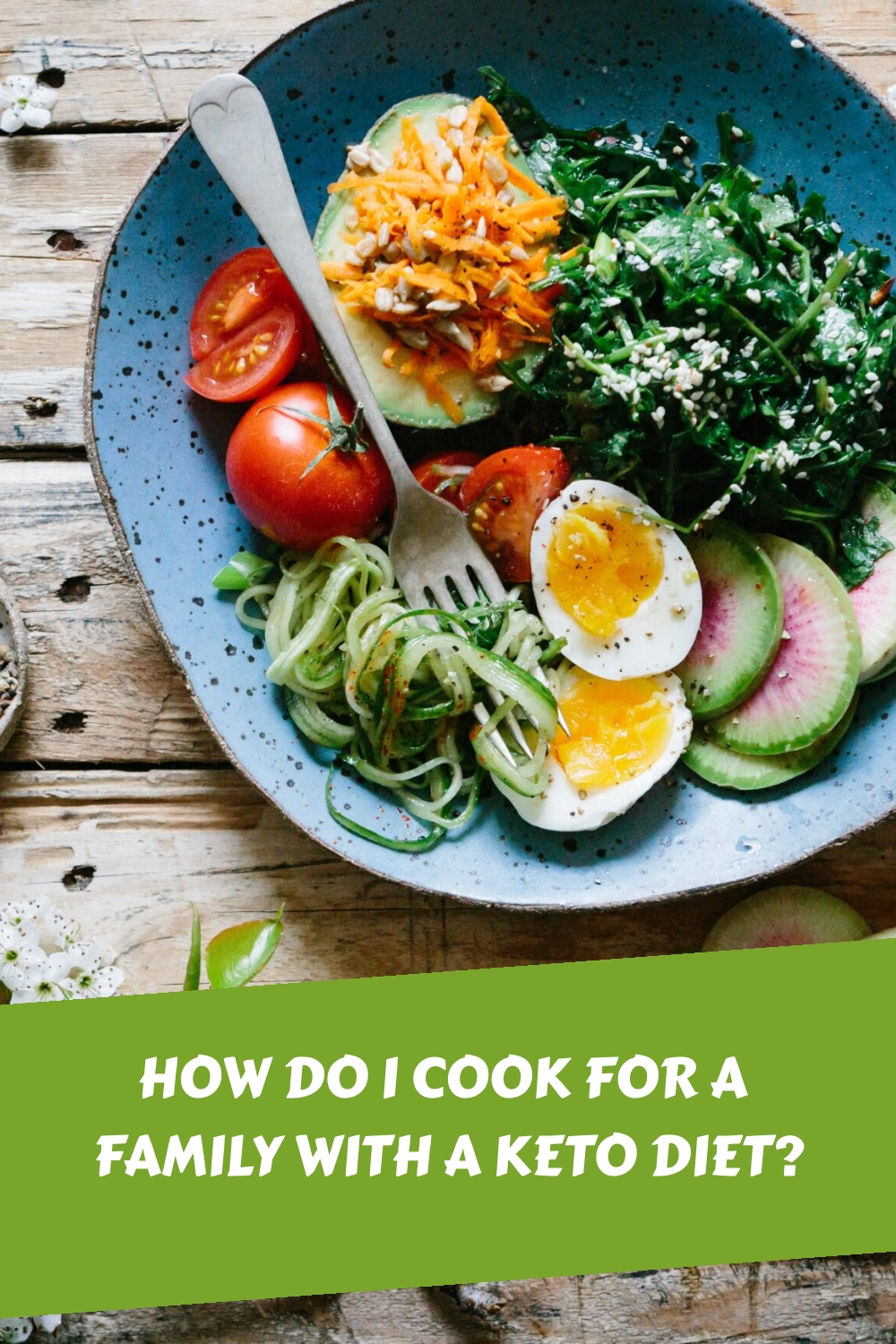
Are you looking for ways to successfully cook for your entire family while following a keto diet? It might seem challenging at first, but with a little creativity and planning, you can create delicious, satisfying meals that the whole family will enjoy. In this article, we will explore some practical tips and strategies to help you navigate the world of cooking with a keto diet for your family. Whether you’re a seasoned keto enthusiast or new to the lifestyle, you’ll find plenty of helpful advice to make mealtime a breeze for the whole family.
Understanding the Keto Diet
What is the keto diet?
The keto diet, short for ketogenic diet, is a low-carbohydrate, high-fat diet that has gained popularity in recent years. The main principle behind the keto diet is to switch the body’s primary source of fuel from carbohydrates to fats. By severely restricting carbohydrate intake and increasing fat consumption, the body enters a metabolic state called ketosis, where it starts burning fat for energy instead of glucose.
Benefits of the keto diet
The keto diet offers various benefits, making it an appealing choice for many individuals. Firstly, it aids in weight loss. By reducing carbohydrate intake, the body taps into its fat stores for energy, leading to consistent and sustainable weight loss. Additionally, the keto diet can improve blood sugar control and insulin sensitivity, making it beneficial for people with diabetes or insulin resistance.
Apart from weight loss and blood sugar management, the keto diet has shown promise in improving cardiovascular health. It can increase levels of HDL (good) cholesterol, lower triglyceride levels, and reduce blood pressure. The keto diet has also been associated with increased mental clarity and improved cognitive function.
Considerations for a family on the keto diet
When adopting the keto diet as a family, there are a few considerations to keep in mind. Firstly, it’s crucial to consult with a healthcare professional before starting on a new dietary approach. This is especially important for children, pregnant women, and individuals with certain medical conditions.
It’s important to ensure the whole family is on board with the keto diet. Educate your family members about the diet and its potential benefits. Involve them in the meal planning and preparation process to make it an enjoyable and inclusive experience.
It’s also important to consider individual taste preferences and dietary restrictions within the family. While the keto diet can be customized to accommodate different food choices, it’s essential to find a balance that suits everyone’s needs. Finally, be prepared for challenges, such as social events and dining out, and come up with strategies to navigate these situations successfully.
Meal Planning for the Keto Diet
Understanding macronutrient ratios
To successfully follow the keto diet, it’s crucial to understand the macronutrient ratios involved. The standard keto diet typically consists of 75% fat, 20% protein, and 5% carbohydrates. However, these ratios can be adjusted based on individual needs and goals.
Tracking macronutrients can be done using various mobile apps or websites that provide nutritional information for different foods. This will help you ensure you’re staying within the desired range of macronutrients and make adjustments as needed.
Stocking up on keto-friendly pantry staples
When embarking on the keto diet, it’s important to stock up your pantry with keto-friendly staples. These include healthy fats such as olive oil, coconut oil, and avocados, as well as a variety of nuts and seeds. You should also have ample supplies of low-carb sweeteners, such as stevia or erythritol, for creating keto-friendly desserts.
Moreover, make sure to have a wide range of low-carb vegetables, such as spinach, broccoli, cauliflower, and zucchini, to add vitamins and fiber to your meals. Lastly, don’t forget to have a good supply of high-quality proteins like eggs, poultry, fish, and grass-fed meats.
Creating a weekly meal plan
Meal planning is a crucial aspect of successfully following the keto diet, especially when cooking for a family. Start by creating a weekly meal plan that includes a variety of keto-friendly recipes for breakfast, lunch, dinner, and snacks.
Begin by selecting a few different breakfast options, such as keto-friendly cereals, egg-based dishes, or low-carb smoothies. For lunch and dinner, focus on replacing grains and starches with keto-friendly alternatives, such as cauliflower rice or zucchini noodles, and incorporate lean proteins and healthy fats into each meal.
Consider preparing one-pot keto meals as they are convenient for busy weeknights and require minimal cleanup. This could include dishes like keto-friendly chili, stir-fries, or casseroles. Plan for snacks that fit within the keto diet, like nuts, cheese, or homemade keto treats.
Once you have your meal plan, create a shopping list to ensure you have all the necessary ingredients for the week. This will not only save you time but also help you stay organized and committed to the keto lifestyle.

Breakfast Ideas
Keto-friendly cereal options
Finding keto-friendly alternatives to traditional breakfast cereals can be a game-changer when following the keto diet. Look for grain-free cereals made with nuts, seeds, and coconut flakes, as these are typically low in carbohydrates and high in healthy fats.
You can also make your own keto-friendly cereal by mixing together a combination of nuts, seeds, and unsweetened coconut flakes. Add a sprinkle of cinnamon and a drizzle of sugar-free syrup or a few drops of liquid stevia for added flavor. Enjoy it with almond milk or full-fat Greek yogurt for a creamy and satisfying breakfast option.
Egg-based breakfast dishes
Eggs are a staple on the keto diet due to their high protein and healthy fat content. They are incredibly versatile and can be incorporated into various breakfast dishes. Consider making omelets or scrambled eggs with a variety of low-carb vegetables, such as spinach, mushrooms, and bell peppers.
Another delicious option is a crustless quiche or frittata. These can be made ahead of time, making them perfect for busy mornings. Include ingredients like cheese, bacon, and diced vegetables for a flavorful and filling breakfast.
Low-carb smoothies
Although smoothies may seem challenging to incorporate into a low-carb diet, they can be made keto-friendly with a few adjustments. Instead of using high-sugar fruits, opt for low-carb options like berries or avocado.
To add creaminess and healthy fats, include ingredients like coconut milk, almond milk, or Greek yogurt. You can also supplement with a scoop of low-carb protein powder or add a tablespoon of nut butter for added flavor and satiety.
Experiment with different combinations of ingredients to find your favorite keto-friendly smoothie recipe. They can be a refreshing and nutritious way to start your day.
Lunch and Dinner Ideas
Replacing grains and starches with keto-friendly alternatives
One of the key aspects of following a keto diet is finding alternatives to grains and starches, which are typically high in carbohydrates. Luckily, there are numerous keto-friendly alternatives available that can be used in place of traditional grains and starches.
Cauliflower rice is a popular substitution for traditional rice. Simply pulse cauliflower florets in a food processor until they resemble rice grains and sauté them in a pan with some oil and seasoning. Zucchini noodles, or “zoodles,” can be made using a spiralizer and cooked to a desired texture.
Other options include using lettuce wraps instead of tortillas or sandwich bread, or making bell pepper “boats” to hold fillings instead of using taco shells or bread rolls. These substitutions allow you to still enjoy your favorite meals without compromising your keto lifestyle.
Incorporating lean proteins and healthy fats
Lean proteins and healthy fats are the building blocks of a satisfying and nutritious keto meal. When planning your lunch and dinner options, aim to include a variety of these macronutrients.
For proteins, consider incorporating chicken, turkey, fish, seafood, or lean cuts of beef or pork. These options are not only low in carbohydrates but also rich in essential amino acids and minerals. Include fatty fish like salmon or mackerel to boost your omega-3 fatty acid intake, which is beneficial for heart health.
Healthy fats can be obtained from sources like avocados, olive oil, coconut oil, nuts, and seeds. These fats not only add flavor and richness to your dishes but also provide a feeling of fullness and satisfaction. Use these fats for cooking or as dressings for salads and vegetables.
One-pot keto meals for easy dinner options
One-pot meals are not only convenient but also ideal for the keto diet. They allow you to combine various ingredients into a single dish, minimizing cleanup and maximizing flavor. Some simple and delicious one-pot keto meal ideas include beef stir-fry with colorful vegetables, chicken curry with cauliflower rice, or a hearty chili made with ground meat and spices.
These one-pot meals can be customized to suit your family’s preferences, and they can often be prepared in advance and reheated when needed. They are also an excellent way to incorporate a variety of vegetables, proteins, and healthy fats into your family’s diet.

Snack and Dessert Options
Keto-friendly snack ideas
Snacks are a great way to keep your energy levels up and satisfy cravings while following the keto diet. Opt for snacks that are low in carbohydrates but high in healthy fats and protein to keep you feeling full and satisfied.
Nuts, such as almonds, walnuts, and macadamia nuts, are excellent choices for a quick and easy keto-friendly snack. They are packed with healthy fats and provide a good amount of fiber. You can also enjoy cheese, both hard and soft varieties, which are high in fat and contain minimal carbohydrates.
Other delicious snack options include beef or turkey jerky, hard-boiled eggs, vegetable sticks with guacamole or cream cheese dip, or even a small portion of full-fat Greek yogurt with a sprinkle of nuts or seeds.
Sugar-free dessert recipes
One of the challenges of following a keto diet is finding suitable options for satisfying your sweet tooth. However, there are many sugar-free dessert recipes available that can still satisfy your cravings without derailing your progress.
Keto-friendly desserts often rely on low-carb sweeteners like stevia, erythritol, or monk fruit extract. These sweeteners provide the sweetness without the added carbohydrates found in traditional sugar.
You can find recipes for sugar-free cheesecakes, brownies, cookies, and even ice cream. Experiment with different flavors and ingredients to find your favorite keto-friendly dessert recipes. Remember to enjoy these treats in moderation as part of a balanced keto lifestyle.
Homemade keto treats
In addition to store-bought snacks and desserts, consider making your own homemade keto treats. This allows you to have complete control over the ingredients and ensures that they align with your family’s dietary needs.
Try making your own kale chips by tossing fresh kale leaves with olive oil, salt, and desired seasonings, then baking them until crispy. These are a savory and nutrient-dense snack option that will satisfy your cravings.
You can also make keto fat bombs, which are small, high-fat snacks that provide a burst of energy. Fat bombs typically consist of a combination of healthy fats like coconut oil or nut butter, sweetened with a low-carb sweetener and flavored with ingredients like cocoa powder, vanilla extract, or shredded coconut.
Experiment with different recipes and customize them to your family’s taste preferences. Homemade keto treats can be a fun and tasty way to stay on track with your diet.
Managing Family Preferences and Challenges
Getting your family on board with the keto diet
When introducing a new diet to your family, it’s important to get everyone on board and create a supportive environment. Educate your family members about the benefits of the keto diet and involve them in the decision-making process.
Encourage open conversation and answer any questions or concerns they may have. Help them understand that the keto diet is not just about restriction but also about nourishing the body with whole, nutrient-dense foods.
Create a positive and inclusive atmosphere by making meal planning and preparation a family activity. Allow your family members to contribute recipe ideas or select their favorite keto-friendly meals from a menu you provide.
Adapting favorite family recipes to fit the keto guidelines
Adapting favorite family recipes to fit the keto guidelines is a great way to ensure that everyone can enjoy familiar and comforting meals. Start by identifying the main sources of carbs in the recipe, such as grains, sugars, or starchy vegetables, and find suitable substitutions.
For example, instead of using flour as a thickening agent in sauces or soups, try using xanthan gum or other low-carb alternatives. Replace traditional pasta or rice with spiralized vegetables, cauliflower rice, or shirataki noodles.
Additionally, experiment with using alternative flours like almond or coconut flour in baking recipes. These flours have lower carbohydrate content and higher fat content compared to traditional wheat flour.
Remember to adjust cooking times and temperatures accordingly, as some ingredients may require different handling. It may take a few experiments to get the desired taste and texture, but your family will appreciate the effort to keep their favorite recipes alive while maintaining a keto lifestyle.
Navigating social events and dining out
Social events and dining out can present challenges when following a keto diet, but it’s still possible to navigate these situations successfully. Planning ahead and communicating with your family and friends is key.
For social events, offer to bring a keto-friendly dish to share. There are many delicious keto appetizers and side dishes that everyone can enjoy. This way, you can ensure there will be at least one dish that aligns with your dietary needs.
When dining out, research the menu of the restaurant beforehand and look for keto-friendly options. Many restaurants offer low-carb alternatives to traditional dishes, such as lettuce wraps instead of buns for burgers or grilled vegetables instead of french fries as a side.
If there are limited options, consider asking for modifications to the menu items, such as requesting grilled chicken or fish instead of breaded options, or asking for a salad without croutons or the dressing on the side.
Remember, it’s important to enjoy social events and dining out while still staying true to your goals. Don’t be afraid to ask questions, make special requests, or adapt your choices to suit your keto lifestyle.

Meal Preparation and Time-Saving Tips
Batch cooking and meal prepping
Meal preparation is an essential aspect of successfully following the keto diet, especially for busy families. Batch cooking and meal prepping can help save time and ensure that healthy meals are readily available throughout the week.
Choose a day of the week to dedicate to meal prep. This can involve cooking large batches of proteins like chicken or ground meat, chopping vegetables, and portioning out meals for the week.
Consider using a slow cooker or Instant Pot to prepare large quantities of stews, soups, or roasts that can be divided into individual portions and frozen for future meals. This allows you to have a variety of homemade, keto-friendly options available, even on the busiest days.
Having pre-prepared meals not only saves time but also prevents you from relying on unhealthy takeout or convenience foods when you’re short on time or energy.
Freezing keto-friendly meals for convenience
Freezing keto-friendly meals is a great way to have quick and convenient options available when you don’t have time to cook from scratch. Prepare large batches of casseroles, stews, or individual portions of meals and freeze them in meal-sized containers or ziplock bags.
Label each container with the name of the dish and the date it was prepared, ensuring that you have a rotation of meals to choose from. This prevents meals from going to waste and allows you to have a diverse selection of keto-friendly options in your freezer.
Remember to thaw frozen meals overnight in the refrigerator or using the defrost function of your microwave. This way, you can enjoy a delicious and nutritious meal without the stress of cooking from scratch.
Using kitchen appliances to save time
Kitchen appliances such as slow cookers, pressure cookers, and air fryers can be a valuable asset when cooking meals for a family on the keto diet.
Slow cookers allow you to cook meals low and slow, resulting in tender and flavorful dishes. You can prepare stews, soups, or pulled meats in the morning and come home to a delicious meal in the evening.
Pressure cookers, like Instant Pot, significantly reduce cooking time by using high pressure and steam. This makes them ideal for tenderizing tough cuts of meat or cooking grains and legumes faster.
Air fryers are great for creating crispy and delicious keto-friendly snacks or side dishes. They use hot air circulation to cook food quickly and with minimal oil, resulting in a healthier alternative to deep frying.
By utilizing these kitchen appliances, you can save time and still enjoy homemade, keto-friendly meals that meet the needs of your family’s busy schedule.
Including Variety and Nutrient Diversity
Incorporating a range of vegetables in your meals
Incorporating a range of vegetables in your meals is crucial for obtaining a wide range of essential vitamins, minerals, and fiber. While certain vegetables are higher in carbohydrates, many are still suitable for the keto diet when consumed in moderation.
Leafy greens like spinach, kale, and Swiss chard are excellent options as they are low in carbohydrates and high in nutrients. Cruciferous vegetables like broccoli, cauliflower, and Brussels sprouts are also keto-friendly and provide numerous health benefits.
Colorful vegetables like bell peppers, tomatoes, and eggplant can add vibrancy and flavor to your meals, and are versatile to cook with. Don’t forget about zucchini, as it can be spiralized into noodles or grated into muffins or bread for added nutrients and texture.
By including a variety of vegetables in your meals, you ensure that your family receives a wide range of essential nutrients while still maintaining a keto lifestyle.
Exploring different protein sources
While meat and poultry are commonly associated with the keto diet, it’s essential to explore different protein sources to add variety to your family’s meals. This can include incorporating plant-based proteins, seafood, and dairy into your meal rotations.
Plant-based proteins like tofu, tempeh, and edamame are low in carbohydrates and rich in protein, making them suitable for the keto diet. They can be used in stir-fries, salads, or curries to add a different texture and flavor profile to your meals.
Seafood, such as salmon, tuna, shrimp, and scallops, are excellent sources of lean protein and omega-3 fatty acids. Including a variety of seafood options helps diversify your family’s nutrient intake.
Dairy products like Greek yogurt, cottage cheese, and hard cheeses are also rich in protein and healthy fats. They can be enjoyed as snacks, added to salads or recipes, or used as bases for creamy sauces or dressings.
By exploring different protein sources, you can avoid food fatigue and maintain a well-rounded and nutritious diet for your family.
Supplementing with essential vitamins and minerals
While the keto diet can provide many essential nutrients, it’s important to supplement certain vitamins and minerals to ensure you and your family are meeting all your nutritional needs.
One nutrient that may require supplementation on the keto diet is electrolytes, such as sodium, potassium, and magnesium. These minerals are often flushed out of the body more rapidly when carbohydrate intake is reduced. Consider adding electrolyte-rich foods like avocados, leafy greens, and nuts to your meal plan.
Additionally, consider taking a high-quality multivitamin to cover any potential gaps in nutrient intake. Consult with a healthcare professional or a registered dietitian to ensure you’re choosing the right supplement for your family’s needs.
Remember, while the keto diet can be nutritionally adequate, it’s important to prioritize a wide variety of whole foods to ensure your family’s nutrient diversity and overall well-being.
Staying Motivated and Overcoming Challenges
Finding support within your family or community
Sticking to any dietary plan can be challenging, but finding support within your family or community can make a significant difference. Surrounding yourself with like-minded individuals who are also following the keto diet or have similar health goals can provide motivation, accountability, and a sense of camaraderie.
Consider joining online support groups, following keto-related social media accounts, or attending local meetups to connect with others who are on a similar journey. Sharing experiences, challenges, and victories can help you stay motivated and overcome any obstacles that come your way.
Within your family, encourage open communication and make sharing achievements and struggles a regular part of your routine. Celebrate each other’s successes and provide support during difficult times. By working together, you can create a supportive atmosphere that fosters long-term success and makes sticking to the keto diet even more enjoyable.
Dealing with cravings and temptations
Cravings and temptations can arise when transitioning to the keto diet, particularly when familiar foods are no longer a part of your regular meals. However, there are strategies to deal with these cravings in a healthy and sustainable way.
When a craving hits, try distracting yourself by engaging in an activity you enjoy, such as going for a walk, reading a book, or calling a friend. Often, cravings subside after a short period of time.
Drinking a glass of water or herbal tea can also help reduce hunger and cravings. Sometimes, what may seem like a craving for food is actually a sign of thirst.
If you feel that your cravings are persistent, consider incorporating healthy, keto-friendly alternatives into your meal plan. For example, if you crave something crunchy, reach for a handful of almonds or pork rinds. For those with a sweet tooth, try indulging in a small portion of sugar-free dark chocolate or a keto-friendly dessert made with natural sweeteners.
Remember that cravings are normal, and occasional indulgence in moderation can still be a part of a balanced keto lifestyle. Focus on the positive changes you’re making for your health and remind yourself of the long-term goals that led you to choose the keto diet in the first place.
Recognizing and celebrating your progress
Embarking on a new dietary lifestyle requires consistency and dedication, but it’s essential to recognize and celebrate your progress along the way. Take the time to reflect on the positive changes you and your family have experienced since starting the keto diet.
Keep a food and mood journal to track how certain foods make you feel and note any improvements in energy levels, sleep quality, or overall well-being. Celebrate milestones like weight loss achievements, improved blood sugar control, or increased mental clarity.
Reward yourself and your family with non-food-related treats, such as a day trip to a favorite destination or purchasing new workout gear. These rewards can serve as a reminder of the progress you’ve made and motivate you to continue on this healthy journey.
Remember, the keto diet is not only about weight loss but also about overall health and well-being. By acknowledging your achievements, you’ll stay motivated and committed to your family’s keto lifestyle.
Consulting with a Healthcare Professional
When to seek professional guidance
While the keto diet can be a safe and effective way to improve health and achieve weight loss goals, it’s important to seek professional guidance, especially if you have any underlying medical conditions or specific dietary requirements.
Consult with a healthcare professional, such as a registered dietitian, before starting the keto diet, particularly if you have diabetes, kidney disease, or any other chronic medical condition. They can provide personalized advice and help ensure that you’re safely following the keto diet while addressing any potential concerns.
A healthcare professional can also help you determine the appropriate macronutrient ratios for you and your family’s needs. They can provide guidance on portion sizes and offer recommendations for any necessary supplementation to prevent nutrient deficiencies.
The importance of regular check-ups
Regular check-ups with a healthcare professional are essential when following any specific dietary plan, including the keto diet. These appointments allow you to monitor any changes in health, track progress, and address any concerns or questions that may arise.
Blood work may be recommended to assess cholesterol levels, blood sugar control, and other important health markers. This can help you and your healthcare professional make any necessary adjustments to your diet or medication regimen.
Be open and honest with your healthcare professional about your dietary choices and discuss any potential challenges or obstacles you may be experiencing. They are there to provide support, guidance, and the necessary medical expertise to ensure your family’s health and well-being are optimized.
Adjusting the keto diet based on individual needs
The keto diet can be highly customizable to suit individual needs and preferences. While the standard macronutrient ratios for the keto diet are often effective, they may not be suitable for everyone.
Individuals, especially children, may require adjustments to their macronutrient ratios and overall calorie intake to support their growth and development. Pregnant or breastfeeding women may need additional carbohydrates or modifications to their diet to ensure adequate nutrient intake for both themselves and their baby.
This is where consulting with a healthcare professional, such as a registered dietitian, becomes crucial. They can help tailor a keto diet plan that meets individual needs, taking into account any medical conditions, age, sex, activity level, or other specific considerations.
Remember, the key to success with the keto diet is personalization and ongoing guidance from a healthcare professional. By listening to your body’s needs and addressing any potential challenges, you can optimize the keto diet to fit your family’s individual requirements.
In conclusion, understanding the keto diet is the first step toward successful implementation for your family. By learning about the benefits, considering the unique challenges and preferences of your family, and mastering meal planning, you can confidently embark on a keto journey together. Remember to focus on incorporating a range of vegetables and protein sources, finding support within your family or community, and celebrating the progress you make along the way. With careful consideration, preparation, and professional guidance, the keto diet can be a sustainable and enjoyable lifestyle that benefits your family’s health and well-being.
Generated with Pin Generator


